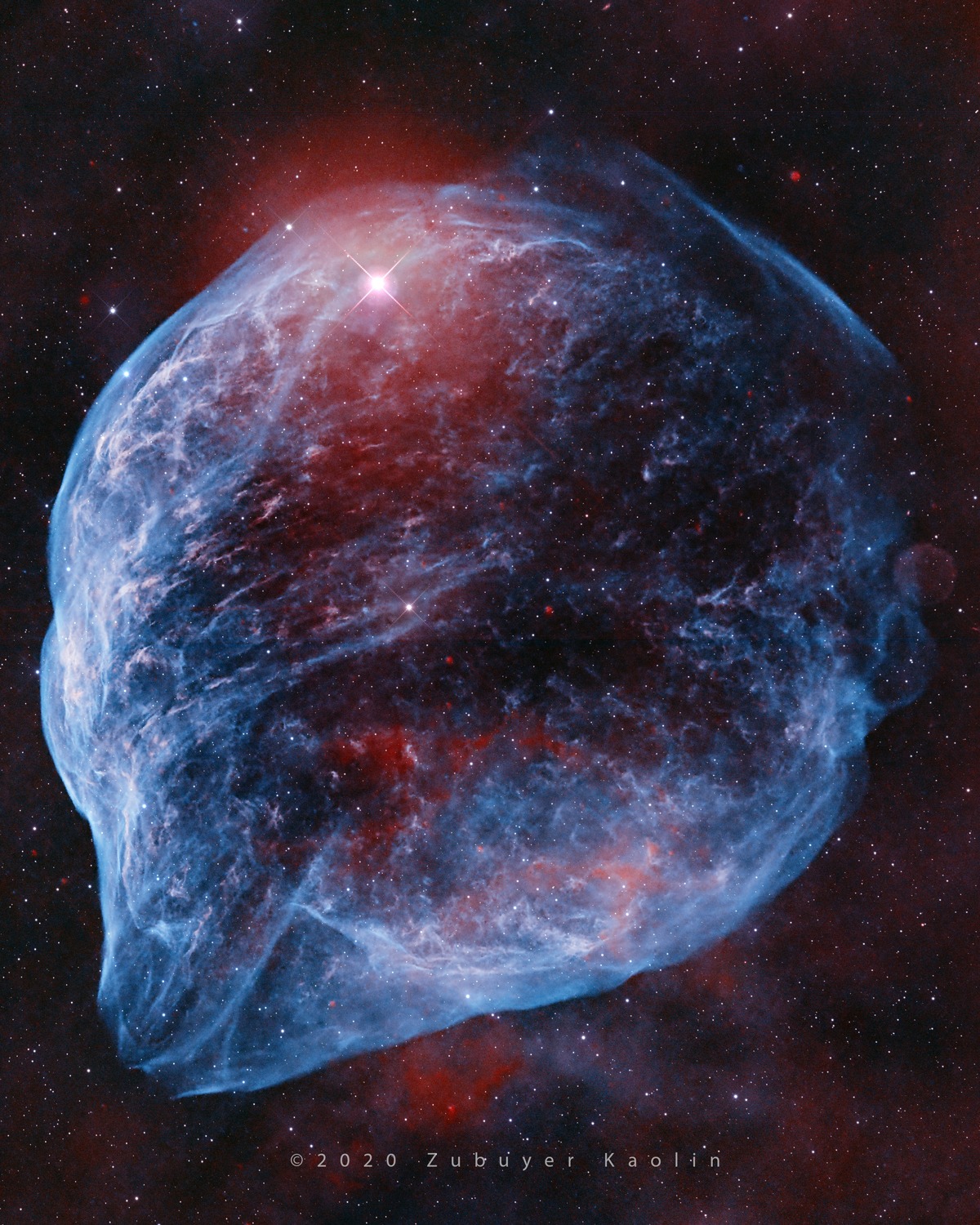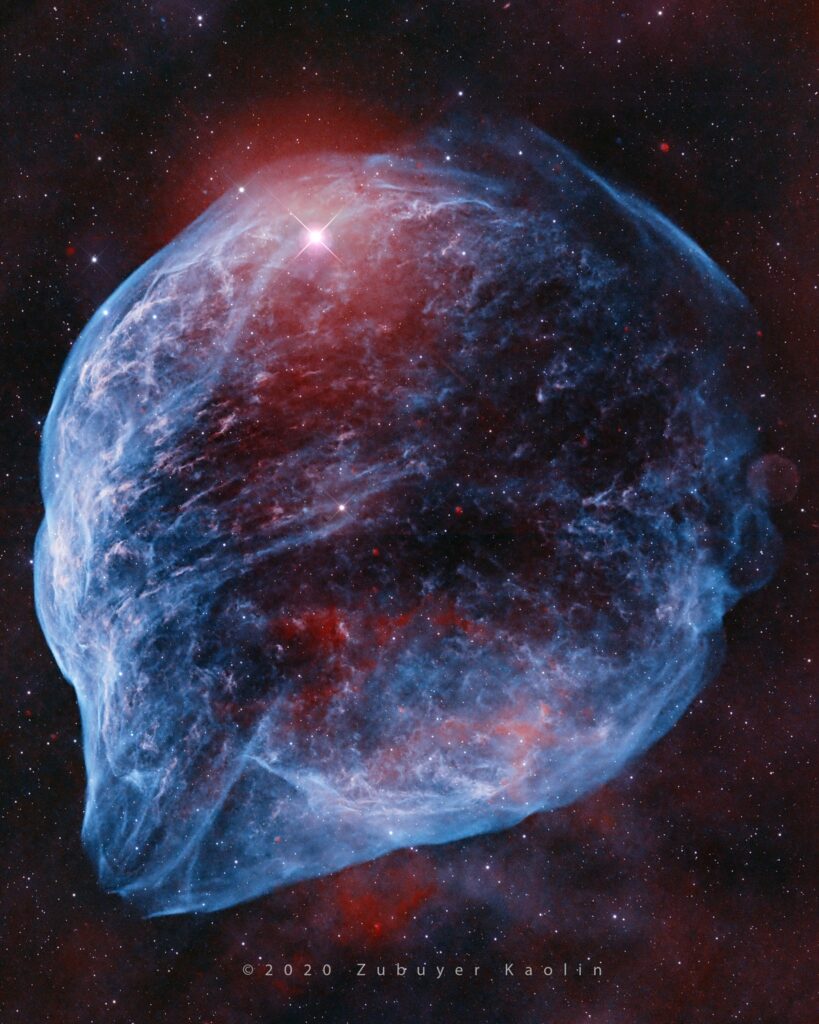Dolphin-Head Nebula: Where a Dying Star Blows a Cosmic Bubble

The Cosmic Dolphin’s Embrace: A Stellar Farewell in Canis Major

(Image: nebula.jpg) Source: Zubayer Kaolin
:Dolphin-Head Nebula (Sharpless 2-308) in Canis Major, a cosmic bubble created by a Wolf-Rayet star.
In the vast cosmic ocean, where stars are born and die, there exists a celestial marvel that captivates with its ethereal beauty and intriguing story. Nestled in the southern skies of Canis Major, approximately 5,200 light-years from Earth, floats the magnificent Dolphin-Head Nebula (also known as Sharpless 2-308 or RCW 11). This isn’t just a glowing gas cloud; it’s a colossal bubble of luminous gas, sculpted by a dying star, whose shape strikingly resembles a dolphin’s head. More than just a pretty picture, it’s a living laboratory of stellar evolution and cosmic processes.
The Birth of a Cosmic Bubble: A Star’s Grand Finale
Imagine, if you will, a titanic artist, crafting a masterpiece across unimaginable distances. This artist is none other than a dying star, EZ Canis Majoris (WR 6), the powerful Wolf-Rayet star at the heart of this cosmic bubble. These rare, massive stars—boasting over 20 times the Sun’s mass and scorching temperatures exceeding 50,000 Kelvin—are renowned for their dramatic farewells.
As they approach the end of their lives, Wolf-Rayet stars shed their outer layers in powerful stellar winds, hurtling through space at speeds exceeding 1,700 kilometers per second. These fierce winds act like a cosmic broom, sweeping up earlier, slower material expelled during the star’s red supergiant phase. This process creates a vast, hollow, glowing shell—the very bubble we now admire as the Dolphin-Head Nebula. This phenomenon perfectly illustrates how stars interact with and shape the surrounding interstellar medium (ISM).
A Bubble’s Tale: Age, Size, and Expansion
This particular cosmic bubble began its story some 70,000 years ago. Since then, this grand shell has been steadily expanding at a remarkable rate of around 60 kilometers per second. Today, it spans an astonishing 60 light-years across, with an apparent diameter of roughly 35 arcminutes in our sky—nearly the size of a full Moon!
While the exact distance of Sharpless 308 can vary slightly depending on the measurement method, most modern estimates place it comfortably between 4,530 and 5,870 light-years away. This distance places it firmly within our own Milky Way Galaxy, making it a significant part of our local cosmic neighborhood.
Why It Glows: Ionized Oxygen & X-Ray Emissions
What gives the Dolphin-Head Nebula its mesmerizing teal-blue glow? The answer lies in the ionized gases within its vast expanse. The nebula’s vibrant color primarily emanates from doubly ionized oxygen (O III), which shines brightly in long-exposure astrophotographs. The emission from hydrogen, in comparison, remains faint.
But the story doesn’t end with visible light. Observations using powerful X-ray telescopes like XMM-Newton and eROSITA have revealed a fiery secret within this cosmic bubble: a two-temperature plasma ranging from a scorching 1 million to 13 million Kelvin! This makes Sharpless 308 one of only two known Wolf-Rayet bubbles in our galaxy to emit X-rays, offering a rare glimpse into the extreme physics at play within such energetic environments. These X-ray emitting nebulae are of particular interest to astronomers studying high-energy phenomena.
The Science Behind the Scene: Unveiling Cosmic Dynamics
Delving deeper into the science, measurements within the nebular shell indicate a density of about 30 electrons per cubic centimeter, while the surrounding interstellar medium is even less dense. The entire shell is estimated to have a mass of roughly 40 solar masses. However, surprisingly, only about 5% of this mass originated directly from the star’s wind; the vast majority has been swept up from the surrounding space. This suggests that much of the mechanical energy unleashed by the star’s powerful winds has already dissipated through radiation and shock interactions, providing crucial insights into stellar evolution and the dynamics of cosmic gases.
When to Watch & How to Shoot It: Your Astrophotography Guide
For those eager to witness this cosmic wonder, the best time to observe the Dolphin-Head Nebula is between December and April. During these months, Canis Major graces our night sky, rising high enough for a good view, especially from the Southern Hemisphere, but also visible from temperate Northern latitudes. To find it, simply look approximately 8 degrees south of the brilliant star Sirius, near Omicron¹ Canis Majoris.
For aspiring amateur astrophotographers hoping to capture its intricate beauty, narrowband filters (specifically O III and Hα) and long exposures are absolutely essential. Many dedicated enthusiasts often stack 4-5 hours of exposure data to reveal the delicate structures within the filamentary gas, transforming faint whispers of light into a breathtaking deep-sky photograph. Patience and proper equipment are key to capturing the essence of this magnificent object.
Other Famous Nebulae and a Cosmic Comparison
While the Dolphin-Head Nebula offers a unique perspective on a star’s late life, the universe is home to countless types of nebulae, each telling its own distinct cosmic story:
- Orion Nebula (M42): This is a prime example of a star-forming nebula, a bustling stellar nursery where new stars are actively being born from collapsing gas and dust. In contrast to the Dolphin-Head, which is a result of stellar death, Orion represents stellar genesis.
- Crab Nebula (M1): This is a prominent supernova remnant, the chaotic aftermath of a massive star’s cataclysmic explosion. Like the Dolphin-Head, it’s tied to the end of a star’s life, but it’s a far more violent and rapid process.
- Ring Nebula (M57): A classic planetary nebula, formed when a smaller, Sun-like star sheds its outer layers in a more gentle process, leaving behind a white dwarf core. Its life cycle is much different from the massive stars that create Wolf-Rayet nebulae like the Dolphin-Head.
The Dolphin-Head Nebula, as a Wolf-Rayet nebula, is relatively rarer compared to other types and provides critical insights into the lifecycles of very high-mass stars. It represents a “bubble” blown by a star’s powerful wind, whereas the Orion Nebula is a birthplace, the Crab Nebula is a destructive aftermath, and the Ring Nebula is a tranquil farewell. These comparisons highlight the incredible diversity of stellar life cycles across the universe.
Why You Should Care: Cosmic Knowledge and Inspiration
The Dolphin-Head Nebula is far more than just a beautiful image; it’s a living laboratory of stellar evolution in action. It provides invaluable insights into how massive stars sculpt their surroundings before their eventual, dramatic supernova events. As one of only a handful of identified Wolf-Rayet bubbles in our galaxy, it offers a rare opportunity to study extreme stellar physics. Furthermore, this nebula beautifully demonstrates the concept of interstellar feedback, showing how the powerful winds from dying stars compress and shape the interstellar medium over tens of thousands of years, influencing the very fabric of future star formation. It is both a source of aesthetic beauty and profound scientific understanding.
Final Thoughts: A Cosmic Whisper
In its quiet expanse, Sharpless 308 whispers a cosmic history—the profound story of a star in its final, magnificent act, carving out a silent, glowing bubble in the cold darkness of space. It stands as a testament to the universe’s boundless beauty and its unending scientific revelations.
So, what do you think? Does the Dolphin-Head Nebula truly resemble its namesake? Share your thoughts on this cosmic marvel in the comments below!


Hey, 777king88 is a serious game!. It’s got a great vibe and plenty of different ways to have fun. Have a look: 777king88
PB338! Site looks smooth and modern. Think I’ll stick around for a while. Check pb338!
Okay, 99jililogin. Another one with those easy logins. Site’s decent, games are fun. Worth a look if you’re into the Jili stuff. Get logged in at 99jililogin.
Alright, gotta say, 234betapp is pretty slick. Easy to navigate, place my bets, and check my winnings on the move. Solid app, no complaints here! 234betapp
688betcc. Has a few good special offers for sports, not bad after all. I use it every other week. I reckon you should get onto it soon!: 688betcc